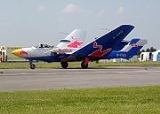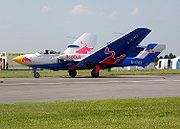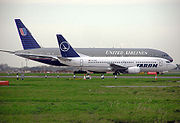
Taxiing
Encyclopedia
Taxiing refers to the movement of an aircraft
on the ground, under its own power, in contrast to towing or push-back where the aircraft is moved by a tug. The aircraft usually moves on wheels, but the term also includes aircraft with skis or floats
(for water-based travel).


An airplane uses taxiway
s to taxi from one place on an airport
to another; for example, when moving from a terminal
to the runway
. The term "taxiing" is not used for the accelerating run along a runway prior to takeoff
, or the decelerating run immediately after landing
.
s or jet engine
s. Reverse thrust for backing up can be generated by thrust reversers on turbine engines, and "beta pitch" (reverse pitch, rather than spinning in reverse) on adjustable pitch propeller aircraft. At low power settings, combustion aircraft engines operate at lower efficiency than at cruise power settings. A typical A320
spends an average of 3.5 hours a day taxiing, using 150gal of fuel. Hybrid electrically driven nosegear are under development to allow high use aircraft to shut down the engines during taxi operations.
Electric taxiing was invented by Delos Aerospace and patented in the US in 2007. Electric taxiing will significantly reduce aircraft fuel burn which is estimated to be as high as 27% of total fuel burn for a 90min flight where waiting in queue adds to the time on the ground. Also tire pre-spin allows for reduced impulse stress applied to the main landing gear thus extending useful life time for the main landing gear while improving passenger comfort.
; the pilot
controlling the direction travelled with their feet. Larger jet aircraft have a tiller wheel on the left side of the aircraft that acts as a steering wheel allowing the nosewheel to be turned hydraulically. Braking is controlled by differential toe or heel brakes. Not all aircraft have steerable wheels, and in some cases steering is solely by means of differential braking (all Van's aircraft
for instance) or solely by means of the rudder (including all floatplane
s).
Rotor downwash limits helicopter hover-taxiing near parked light aircraft.
The use of engine thrust near terminals is restricted due to the possibility of jet blast
damage.
Aircraft
An aircraft is a vehicle that is able to fly by gaining support from the air, or, in general, the atmosphere of a planet. An aircraft counters the force of gravity by using either static lift or by using the dynamic lift of an airfoil, or in a few cases the downward thrust from jet engines.Although...
on the ground, under its own power, in contrast to towing or push-back where the aircraft is moved by a tug. The aircraft usually moves on wheels, but the term also includes aircraft with skis or floats
Buoyancy
In physics, buoyancy is a force exerted by a fluid that opposes an object's weight. In a column of fluid, pressure increases with depth as a result of the weight of the overlying fluid. Thus a column of fluid, or an object submerged in the fluid, experiences greater pressure at the bottom of the...
(for water-based travel).


An airplane uses taxiway
Taxiway
A taxiway is a path on an airport connecting runways with ramps, hangars, terminals and other facilities. They mostly have hard surface such as asphalt or concrete, although smaller airports sometimes use gravel or grass....
s to taxi from one place on an airport
Airport
An airport is a location where aircraft such as fixed-wing aircraft, helicopters, and blimps take off and land. Aircraft may be stored or maintained at an airport...
to another; for example, when moving from a terminal
Airport terminal
An airport terminal is a building at an airport where passengers transfer between ground transportation and the facilities that allow them to board and disembark from aircraft....
to the runway
Runway
According to ICAO a runway is a "defined rectangular area on a land aerodrome prepared for the landing and take-off of aircraft." Runways may be a man-made surface or a natural surface .- Orientation and dimensions :Runways are named by a number between 01 and 36, which is generally one tenth...
. The term "taxiing" is not used for the accelerating run along a runway prior to takeoff
Takeoff
Takeoff is the phase of flight in which an aerospace vehicle goes from the ground to flying in the air.For horizontal takeoff aircraft this usually involves starting with a transition from moving along the ground on a runway. For balloons, helicopters and some specialized fixed-wing aircraft , no...
, or the decelerating run immediately after landing
Landing
thumb|A [[Mute Swan]] alighting. Note the ruffled feathers on top of the wings indicate that the swan is flying at the [[Stall |stall]]ing speed...
.
Taxi Propulsion
The thrust to propel the aircraft forward comes from its propellerPropeller (aircraft)
Aircraft propellers or airscrews convert rotary motion from piston engines or turboprops to provide propulsive force. They may be fixed or variable pitch. Early aircraft propellers were carved by hand from solid or laminated wood with later propellers being constructed from metal...
s or jet engine
Jet engine
A jet engine is a reaction engine that discharges a fast moving jet to generate thrust by jet propulsion and in accordance with Newton's laws of motion. This broad definition of jet engines includes turbojets, turbofans, rockets, ramjets, pulse jets...
s. Reverse thrust for backing up can be generated by thrust reversers on turbine engines, and "beta pitch" (reverse pitch, rather than spinning in reverse) on adjustable pitch propeller aircraft. At low power settings, combustion aircraft engines operate at lower efficiency than at cruise power settings. A typical A320
Airbus A320 family
The Airbus A320 family is a family of short- to medium-range, narrow-body, commercial passenger jet airliners manufactured by Airbus Industrie.Airbus was originally a consortium of European aerospace companies, and is now fully owned by EADS. Airbus's name has been Airbus SAS since 2001...
spends an average of 3.5 hours a day taxiing, using 150gal of fuel. Hybrid electrically driven nosegear are under development to allow high use aircraft to shut down the engines during taxi operations.
Electric taxiing was invented by Delos Aerospace and patented in the US in 2007. Electric taxiing will significantly reduce aircraft fuel burn which is estimated to be as high as 27% of total fuel burn for a 90min flight where waiting in queue adds to the time on the ground. Also tire pre-spin allows for reduced impulse stress applied to the main landing gear thus extending useful life time for the main landing gear while improving passenger comfort.
Taxi Control
Steering is achieved by turning a nose wheel or tail wheel/rudderRudder
A rudder is a device used to steer a ship, boat, submarine, hovercraft, aircraft or other conveyance that moves through a medium . On an aircraft the rudder is used primarily to counter adverse yaw and p-factor and is not the primary control used to turn the airplane...
; the pilot
Aviator
An aviator is a person who flies an aircraft. The first recorded use of the term was in 1887, as a variation of 'aviation', from the Latin avis , coined in 1863 by G. de la Landelle in Aviation Ou Navigation Aérienne...
controlling the direction travelled with their feet. Larger jet aircraft have a tiller wheel on the left side of the aircraft that acts as a steering wheel allowing the nosewheel to be turned hydraulically. Braking is controlled by differential toe or heel brakes. Not all aircraft have steerable wheels, and in some cases steering is solely by means of differential braking (all Van's aircraft
Van's Aircraft
Van's Aircraft is an American kit aircraft manufacturer, founded by Richard "Van" VanGrunsven in 1973.Van's RV series of aircraft, from the single seat RV-3 to the latest RV-12, are all-aluminum, low-wing monoplanes of monocoque construction...
for instance) or solely by means of the rudder (including all floatplane
Floatplane
A floatplane is a type of seaplane, with slender pontoons mounted under the fuselage; only the floats of a floatplane normally come into contact with water, with the fuselage remaining above water...
s).
Safety
When taxiing, aircraft travel slowly. This ensures that they can be stopped quickly and do not risk wheel damage on larger aircraft if they accidentally turn off the paved surface.Rotor downwash limits helicopter hover-taxiing near parked light aircraft.
The use of engine thrust near terminals is restricted due to the possibility of jet blast
Jet blast
Jet blast is the phenomenon of rapid air movement produced by the jet engines of aircraft, particularly on or before takeoff.A large jet-engined aircraft can produce winds of up to 100 mph up to 200 feet behind it at 40% maximum rated power...
damage.

